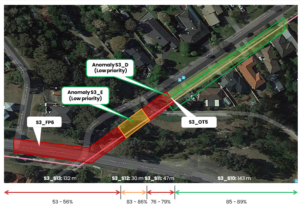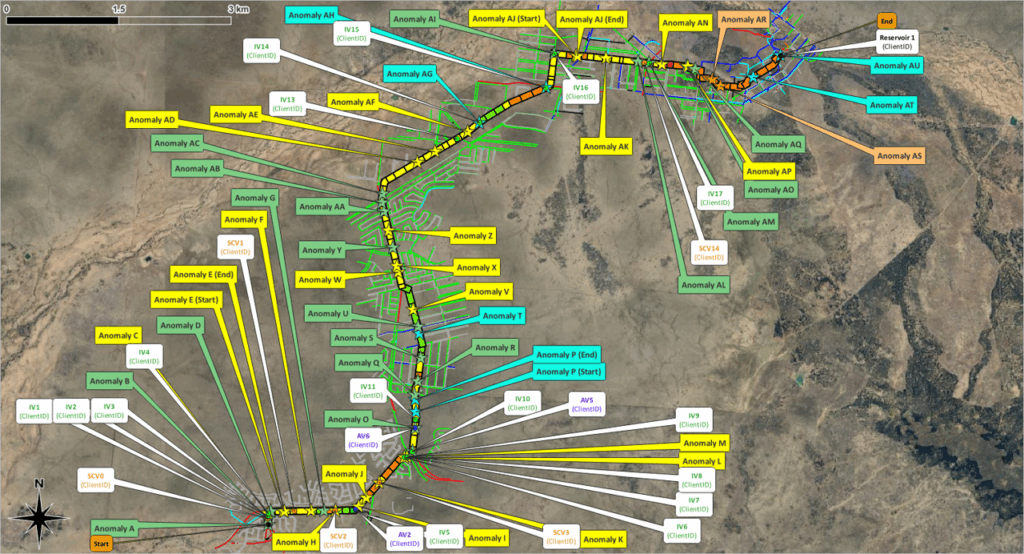A Guide for Water, Mining and Local Government Sectors
As a water utility, mining company or council responsible for managing extensive water networks, maintaining the integrity and functionality of your pipelines is absolutely crucial. Australian designed and developed, Pipeline Condition Assessment Technology – Nexus (p-CAT™ Nexus) offers a sophisticated method to evaluate the condition of your pipelines, helping you make informed decisions about maintenance, repairs, and replacements. Here’s what you can expect from a p-CAT™ Nexus condition assessment and how you can use the information to enhance your water network management.
Deliverables from a p-CAT™ Nexus Condition Assessment
p-CAT™ Nexus delivers two main types of results through its advanced analysis techniques: Sub-Sectional Pipeline Condition Assessment and Localised Fault Detection. Each type provides specific insights into the state of your pipelines.
- Sub-Sectional Pipeline Condition Assessment
This aspect of the assessment breaks down the pipeline into sub-sections based on areas with similar wall thickness. Here’s what you will receive:
- Remaining Wall Thickness: The assessment measures the remaining wall thickness of the pipeline in various sub-sections. This information is critical to understanding the structural integrity and expected lifespan of different segments of your pipeline.
- Internal Cement Lining Loss (Spalling): For pipelines with cement linings, the p-CAT™ Nexus assessment will identify areas where the internal lining has deteriorated. Spalling can lead to increased roughness, reducing the efficiency of water flow and increasing the risk of further damage.
- Pipe Material Changes: The technology can detect changes in pipe material along the pipeline. Identifying these changes is important for targeted maintenance and for understanding the historical modifications to the pipeline network.
- Cement Matrix Loss in Asbestos Cement (AC) Pipes: In AC pipes, p-CAT™ Nexus assesses the loss of the cement matrix. This information helps in evaluating the risk of pipe failure and planning for the replacement of aging or deteriorating AC pipes.

- Localised Fault Detection
This analysis focuses on pinpointing specific issues within the pipeline. The deliverables include:
- Internal Blockages and Restrictions: Identification of blockages or areas with significant restrictions is crucial for maintaining flow efficiency and preventing service disruptions.
- Air and Gas Pockets: Detection of air and gas pockets helps in preventing water hammer and other related issues that can cause significant damage to the pipeline.
- Assessment of Closed or Partially Closed Valves: Ensuring that valves are operating correctly is vital for controlling water flow and pressure within the network. The p-CAT™ assessment can identify valves that are not fully open or closed, which might otherwise go unnoticed.
- Unknown Connections: The technology can identify previously unknown connections within the pipeline network. This information is essential for accurate mapping and management of the water network.

Next Steps After Receiving Your p-CAT™ Nexus Assessment
Once you have received the detailed report from your p-CAT™ Nexus condition assessment, the next steps involve strategic planning and implementation of maintenance and improvement measures. Here’s a suggested approach:
- Prioritise Repairs and Replacements
Use the data on remaining wall thickness and internal lining loss to prioritise sections of the pipeline that need immediate attention. Focus on high-risk areas first to prevent potential failures.
- Plan Preventative Maintenance
Develop a schedule for preventative maintenance based on the condition of different sub-sections. Regular maintenance can extend the lifespan of your pipelines and reduce the frequency of emergency repairs.
- Optimise Pipeline Operations
Address localised faults such as blockages, air pockets, and valve issues to ensure optimal operation of the pipeline network. This step will improve water flow efficiency and reduce operational costs.
- Update Asset Management Systems
Integrate the new data into your asset management systems. This updated information will enhance your ability to monitor pipeline conditions and make data-driven decisions in the future.
- Inform Stakeholders
Share the findings with relevant stakeholders, including engineers, maintenance crews, and local government officials. Transparency in the condition and management of the water network can facilitate better cooperation and support for necessary interventions.
- Budget for Long-term Investments
Use the insights from the p-CAT™ Nexus assessment to plan and budget for long-term investments in pipeline infrastructure. This proactive approach can help in securing funding and resources for significant upgrades and replacements.
A p-CAT™ Nexus condition assessment provides comprehensive insights into the state of your water pipelines, enabling you to make informed decisions about maintenance and improvements. By understanding the specific deliverables and strategically planning your next steps, you can enhance the reliability and efficiency of your water network, ensuring a sustainable supply for the communities you serve.
With projects spanning Australia, New Zealand, Singapore, Asia, UK, Europe, China, USA and the Middle East, chat with us today about how p-CAT Nexus can assist you in identifying assets in need of rehabilitation or replacement.







